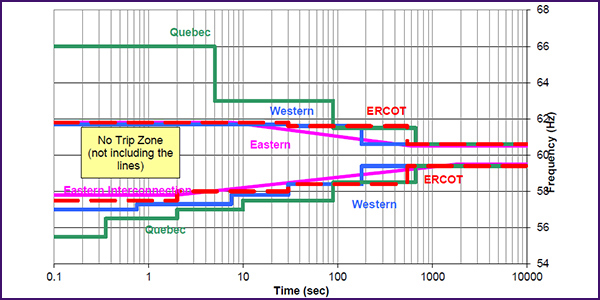By Rich Heidorn Jr.
Transmission owners will not be covered by revisions to NERC reliability standard PRC-024-2 concerning inverter-based generation resources, the standard development team said Wednesday (Project 2018-04).
In a comment period that closed July 26, respondents gave a “resounding yes” to extending the standard to cover the setting of voltage and frequency protective relays on generator step-up (GSU) transformers or collector transformers, NERC standards developer Mat Bunch said. Twenty-nine entities endorsed covering the GSUs, with eight in opposition. (See Comments due July 26 on Revised Inverter Standard.)
But Bunch said the standard will not cover TOs that own a GSU or collector transformer and are not registered as generator owners because the comments did not identify any such TOs in the U.S. “This is not a continent-wide issue at this time,” Bunch said. “We still can’t find one in the U.S.”
TO Hydro-Québec TransÉnergie said it owns the GSUs associated with about 37 GW of generation that it does not own. “We are not registered as a GO since we do not own any generators,” the company said.
Bunch said most of the “no” votes were indications of opposition to TOs being covered.
“What I heard back from people unofficially [was] if TOs weren’t included, industry could probably support … the standard,” Bunch said. “I do know that people were voting ‘no’ on the standard only because of the TO issue.”
Comments
The SDT is working to develop a revised standard to address issues identified in the Inverter-Based Resource Performance Task Force’s PRC-024-2 Gaps Whitepaper. The task force was formed in 2017 following the August 2016 Blue Cut wildfire, when 1,200 MW of solar disconnected, and the October 2017 Canyon 2 fire, which resulted in the loss of more than 900 MW.
The stakeholder comments came in response to a “supplemental” standard authorization request (SAR), which expanded the project’s scope to include the GSU and collector transformers and consider TO requirements.
Dominion Energy said GSUs and collector transformers “have never been part of PRC-024” and that the project’s scope “should NOT be expanded to an issue that has not been substantiated and reliability risk identified.”
Southern Co. contended the supplemental SAR did not make the case for expanding the scope, saying “the protection elements on main station transformers have not been reported to have been, nor are known to have been, the cause of plant tripping due to transmission system voltage or frequency disturbances.”
American Electric Power raised procedural concerns, saying NERC’s Standards Process Manual does not allow “multiple, concurrent SARs to govern a single NERC project.”
“If this project’s scope or direction needs to be revised, the current and governing SAR should be revised accordingly rather than developing an additional SAR to somehow expand upon its predecessor,” AEP said.
Ontario’s Independent Electricity System Operator said it supported the amended SAR but that it didn’t go far enough. “The scope should also include auxiliaries critical to maintain plant output. The supply to other critical auxiliaries, like lubricating systems, [and] governing and excitation systems that allow the generating unit to maintain its output level, must also meet PRC-024 requirements for reliability.”
The ISO/RTO Council Standards Review Committee noted that PRC-024 was developed when generators and GSU transformers were generally controlled by the same asset owner. “As such, coordination between generator protection schemes and associated transmission equipment may not have required any explicit requirements and the PRC-024 applicability to only the generator side of the interconnection was sufficient. Today, with the separation of ownership of assets at the generator point of interconnection, NERC must ensure the intent of PRC-024 is met through adding explicit requirements which may or may not fall within the original construct of the standard,” it said.
In the first ballot, which ended May 31, the proposed standard was supported by a weighted vote of 3.085-2.815 (52.3% in favor). It will be posted for a second ballot Sept. 13, closing Oct. 28.
A standard must receive two-thirds support before going to the final ballot. Once that threshold is reached, the drafting team and NERC staff will review the comments received and determine whether additional changes are necessary. If there are substantive changes, it is posted for an additional 45-day ballot. If the changes are minor, it would proceed to a 10-day final ballot, according to NERC spokeswoman Kimberly Mielcarek.





